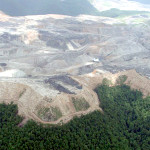
Rainforest Action Network (RAN), Sierra Club and BankTrack released the fifth annual coal finance report card, Extreme Investments, Extreme Consequences, last week that tracks the financiers of the worst-of-worst coal companies. The report shows that even as high-profile bankruptcies and costly environmental cleanup settlements illustrate the growing risks involved with lending to coal companies, U.S. banks provided $31 billion in financing for coal in 2013.

The report ranks Citigroup as the top financier of the U.S. coal-fired power plant fleet with $6.5 billion in loans and underwriting, and Barclays as the lead financier of mountaintop removal (MTR) coal mining. Meanwhile, a positive trend is also developing as Wells Fargo and JPMorgan Chase both committed to end their financial relationships with major MTR coal mining companies; both achieved the highest grade in the report card’s five-year history. Goldman Sachs also received recognition for stepping away from the contentious Gateway Pacific Coal Export Terminal proposal in the ecologically sensitive Puget Sound. Citigroup, Bank of America, Morgan Stanley and PNC Financial all received lower grades than in 2013 for their continued financing of MTR.
“The gap is widening between banks who have cut ties with extreme coal companies and those still holding on to those risky relationships,” said Ben Collins, campaigner for Rainforest Action Network’s Energy and Finance Program. “Leading banks are beginning to plan for a carbon-constrained future by moving away from companies that contaminate public water supplies, threaten our climate, and increasingly put shareholders at risk. At this point any company still banking on coal has its head in the sand.”
This year, the report emphasizes the coal industry’s impact on water contamination, including a case study investigating the ten lawsuits filed against Alpha Natural Resources for selenium pollution from MTR mines. Case studies in this year’s report also expose coal industry bankruptcies and risky coal power plant transactions, including bankruptcies at MTR coal producers Patriot Coal and James River Coal, and sales of coal plants involving Dynegy in Illinois and Dominion Energy in Massachusetts.
“Mountaintop removal coal mining is destructive not only to the environment but to the economy and health of Appalachians as well,” said Mark Kresowik, a policy analyst for the Beyond Coal campaign at the Sierra Club. “Over the last year financially prohibitive fines and settlements like those against Arch Coal and Alpha Natural Resources show that MTR is an awful investment for the American banking industry.”
The report urges banks to plan for a carbon-constrained future. Specific recommendations include phasing out lending to producers of mountaintop removal coal and coal-fired power, withholding financing for new coal export terminals and ensuring that coal financing deals commit banks and companies to emissions reductions.
——–
YOU ALSO MIGHT LIKE
Willie Nelson Joins Fight to Stop Mountaintop Removal Coal Mining
Why Investing in Aging Coal Plants is a Losing Bet
Supreme Court Rejects Coal Industry Lawsuit, Defends EPA Veto of Mountaintop Removal Mine
——–
[source: http://ecowatch.com/2014/04/21/banks-investment-coal/]

Leave a Reply
You must be logged in to post a comment.